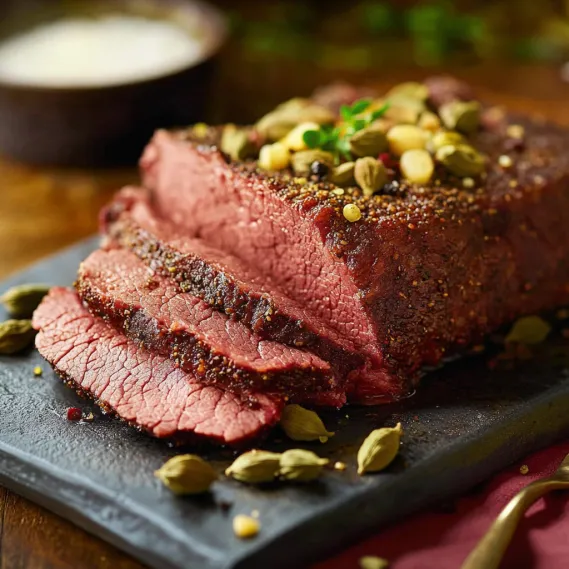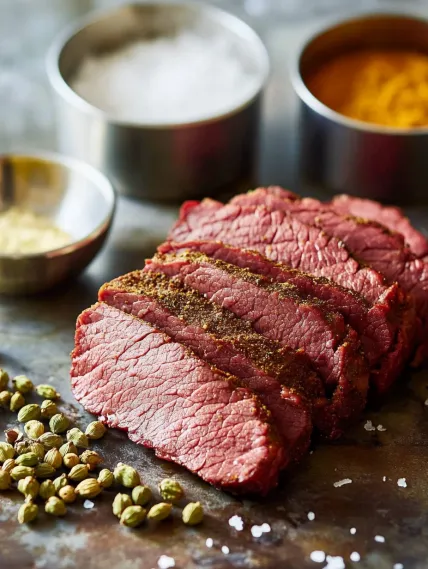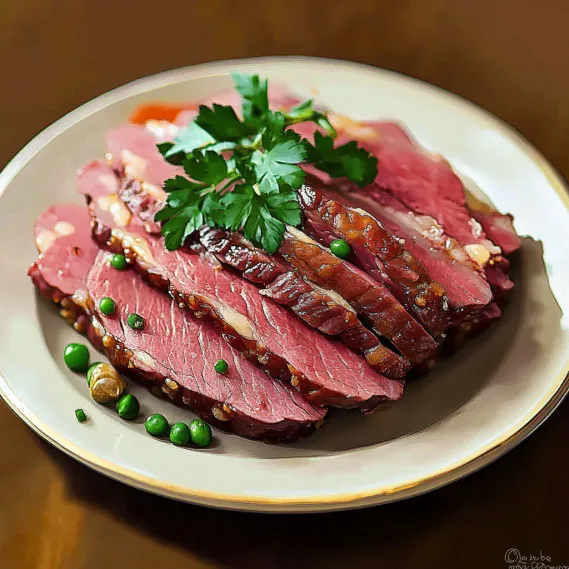 Pin it
Pin it
Master the art of making Homemade Corned Beef with this traditional brining method. This process transforms ordinary beef brisket into pink, tender, and flavorful meat. While it requires planning ahead, most preparation time is hands-off as the brine works its magic in your refrigerator. The result is dramatically superior to store-bought versions.
Last St. Patrick's Day, I served homemade corned beef to my extended family alongside store-bought versions. The homemade beef disappeared first, with everyone commenting on its superior texture and balanced flavor profile. My uncle, who considers himself a corned beef connoisseur, immediately asked for the recipe.
Essential Ingredients and Selection Tips
- Beef Brisket: Look for well-marbled meat. The flat cut slices more uniformly, while the point cut offers more flavor.
- Kosher Salt: Measure by weight as different brands have varying densities. Diamond Crystal and Morton's are not interchangeable.
- Pink Curing Salt: Also called Prague Powder #1, it provides traditional color and enhances preservation.
- Brown Sugar: Balances the saltiness while helping develop flavor during the curing process.
- Pickling Spice: Creating your own blend ensures the freshest, most vibrant flavors in the final product.
I've discovered that grinding whole spices just before making the brine produces dramatically more aromatic results than using pre-ground spices. This small extra step makes a noticeable difference in the final flavor of your corned beef.
Detailed Cooking Instructions
- Step 1: Create Your Signature Spice Blend
- Toast 1 tablespoon each of allspice berries, mustard seeds, coriander seeds, red pepper flakes, and black peppercorns, along with 2 teaspoons of whole cloves and ½ cinnamon stick broken into pieces. In a dry skillet, combine 6 crumbled bay leaves, 2 teaspoons ground ginger, and ½ teaspoon lemon zest. Toast over medium heat until fragrant, about 2-3 minutes. Remove from heat and cool completely to room temperature before refrigerating until cold.
- Step 2: Prepare the Brine
- In a large pot, combine 1 gallon of water, 300g kosher salt, 5 teaspoons pink curing salt (if using), ½ cup brown sugar, and 3 tablespoons of your spice blend. Bring to a boil, stirring to dissolve all solids, then remove from heat and cool completely to room temperature before refrigerating until cold.
- Step 3: Brine the Brisket
- Place a 4-5 pound beef brisket in a non-reactive container (glass, ceramic, or food-grade plastic) and fully submerge in the chilled brine. Cover tightly and refrigerate for 5-7 days, flipping the meat daily to ensure even curing throughout.
- Step 4: Test for Proper Curing
- After the curing period, remove the brisket and cut a small piece from the corner to check for doneness. If using pink salt, the meat should be pink throughout; if not using pink salt, it should be uniformly gray from edge to center. Rinse the brisket thoroughly under cold water to remove excess salt.
- Step 5: Cook the Corned Beef
- Place the rinsed brisket in a large pot, cover with fresh water, and add the remaining tablespoon of pickling spice. Bring to a boil, then reduce to a gentle simmer and cook for about 3 hours or until fork-tender, with an internal temperature of 195°F.
 Pin it
Pin it
I created my first batch of homemade corned beef after being disappointed by the overly salty, artificially flavored store versions. The difference was remarkable – meat that tasted of warm spices and beef rather than just salt. Now my family expects homemade corned beef every March.
 Pin it
Pin it
Understanding the Science of Curing
The curing process works through osmosis as salt draws moisture from meat while penetrating muscle fibers. This creates an environment inhospitable to harmful bacteria. Sodium nitrite in pink curing salt reacts with myoglobin, producing the characteristic color and enhancing flavor while preventing spoilage. The curing process requires continuous refrigeration to prevent bacterial growth.
Customizing Your Spice Blend
Over years of experimentation, I've developed variations on traditional pickling spice. Try adding cinnamon for warmth, dried orange peel for brightness, or juniper berries for piney notes. Mace blades bring nutmeg-like depth, making each batch unique while maintaining classic corned beef flavors.
Serving Beyond St. Patrick's Day
While corned beef and cabbage is traditional, this versatile meat shines in many dishes. Use it in Reuben sandwiches, crispy breakfast hash, or tacos with pickled cabbage and horseradish cream. The deep, spiced flavors pair beautifully with potatoes, cabbage, and hearty breads.
Troubleshooting Common Issues
Too salty? Soak the cured brisket in cold water for 1-2 hours before cooking, changing water every 30 minutes. Tough meat? Simmer longer - collagen needs time to break down. Pale color without pink salt is normal and doesn't affect taste. Always slice corned beef against the grain for maximum tenderness.
Making it a Family Tradition
In my household, corned beef has become a March tradition. We start brining a week before St. Patrick's Day, turning the brisket daily. Children love participating in this process, offering opportunities to discuss food science and heritage cooking techniques.
 Pin it
Pin it
Chef's Helpful Tips
- For the most tender results, cook low and slow, then rest wrapped in foil for 30 minutes
- Replace 2 cups of cooking water with dark stout beer for deeper flavor
- Strain and reduce the cooking liquid to use when reheating leftovers
- Use leftover corned beef to make the world's best hash with potatoes and eggs
- Save some pickling spice to add to the cooking water for enhanced flavor
My journey with homemade corned beef began from curiosity and became a cherished ritual. The process reminds me that good food often requires patience—allowing simple ingredients time to develop their full potential. Each bite connects past and present through flavor and technique.
Frequently Asked Questions
- → Is pink curing salt necessary for homemade corned beef?
- Pink curing salt (sodium nitrite) is optional but traditionally used for two reasons: it gives corned beef its characteristic pink color and helps prevent bacterial growth during the curing process. Without it, your corned beef will taste similar but will be gray-brown in color. If you choose to omit it, ensure you keep the meat refrigerated during the entire curing process.
- → Can I use a different cut of beef besides brisket?
- While brisket is traditional for corned beef because of its fat content and texture, you can use other tough cuts like beef round or chuck roast. These cuts will work with the same brining process, though the final texture may differ slightly. Regardless of the cut, look for one with good marbling for the most flavor and tenderness.
- → What should I do if my corned beef is too salty?
- If your corned beef tastes too salty after brining, you can soak it in cold water for a few hours before cooking, changing the water every hour. Another option is to use more water during the cooking process and/or skip adding salt to any vegetables you might cook with it. Remember that the next time you make the recipe, you can reduce the brining time or salt quantity.
- → Can I add vegetables to cook with the corned beef?
- Yes! Traditional additions include cabbage, potatoes, and carrots. Add these vegetables to the pot during the last 30 minutes of cooking the corned beef. The cooking liquid is flavorful and perfect for cooking vegetables. You can also strain the cooking liquid, reduce it slightly, and use it as a sauce for the meat and vegetables.
- → How can I make corned beef more tender?
- For maximum tenderness, cook the corned beef very slowly at a bare simmer. Rapid boiling can toughen the meat. Alternatively, after brining, you can cook the corned beef in a slow cooker on low for 8-10 hours or pressure cook it for about 90 minutes. Regardless of cooking method, always slice the meat against the grain for the most tender bite.
